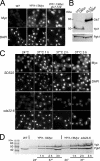Ypi1, a positive regulator of nuclear protein phosphatase type 1 activity in Saccharomyces cerevisiae
- PMID: 18172024
- PMCID: PMC2262978
- DOI: 10.1091/mbc.e07-05-0499
Ypi1, a positive regulator of nuclear protein phosphatase type 1 activity in Saccharomyces cerevisiae
Abstract
The catalytic subunit of protein phosphatase type 1 (PP1) has an essential role in mitosis, acting in opposition to the Ipl1/Aurora B protein kinase to ensure proper kinetochore-microtubule interactions. However, the regulatory subunit(s) that completes the PP1 holoenzyme that functions in this capacity is not known. We show here that the budding yeast Ypi1 protein is a nuclear protein that functions with PP1 (Glc7) in this mitotic role. Depletion of cellular Ypi1 induces mitotic arrest due to activation of the spindle checkpoint. Ypi1 depletion is accompanied by a reduction of nuclear PP1 and by loss of nuclear Sds22, a Glc7 binding partner that is found in a ternary complex with Ypi1 and Glc7. Expression of a Ypi1 variant that binds weakly to PP1 also activates the spindle checkpoint and suppresses the temperature sensitivity of an ipl1-2 mutant. These results, together with genetic interactions among YPI1, GLC7, and SDS22 mutants, indicate that Ypi1 and Sds22 are positive regulators of the nuclear Glc7 activity that is required for mitosis.
Figures







Similar articles
-
YPI1 and SDS22 proteins regulate the nuclear localization and function of yeast type 1 phosphatase Glc7.J Biol Chem. 2007 Feb 2;282(5):3282-92. doi: 10.1074/jbc.M607171200. Epub 2006 Dec 1. J Biol Chem. 2007. PMID: 17142459
-
Suppressors of ipl1-2 in components of a Glc7 phosphatase complex, Cdc48 AAA ATPase, TORC1, and the kinetochore.G3 (Bethesda). 2012 Dec;2(12):1687-701. doi: 10.1534/g3.112.003814. Epub 2012 Dec 1. G3 (Bethesda). 2012. PMID: 23275890 Free PMC article.
-
Glc7/protein phosphatase 1 regulatory subunits can oppose the Ipl1/aurora protein kinase by redistributing Glc7.Mol Cell Biol. 2006 Apr;26(7):2648-60. doi: 10.1128/MCB.26.7.2648-2660.2006. Mol Cell Biol. 2006. PMID: 16537909 Free PMC article.
-
Function of protein phosphatase-1, Glc7, in Saccharomyces cerevisiae.Adv Appl Microbiol. 2010;73:27-59. doi: 10.1016/S0065-2164(10)73002-1. Adv Appl Microbiol. 2010. PMID: 20800758 Review.
-
Protein phosphatase 1: life-course regulation by SDS22 and Inhibitor-3.FEBS J. 2022 Jun;289(11):3072-3085. doi: 10.1111/febs.16029. Epub 2021 Jun 13. FEBS J. 2022. PMID: 34028981 Review.
Cited by
-
Glucose-induced posttranslational activation of protein phosphatases PP2A and PP1 in yeast.Cell Res. 2012 Jun;22(6):1058-77. doi: 10.1038/cr.2012.20. Epub 2012 Jan 31. Cell Res. 2012. PMID: 22290422 Free PMC article.
-
The budding yeast Cdc48(Shp1) complex promotes cell cycle progression by positive regulation of protein phosphatase 1 (Glc7).PLoS One. 2013;8(2):e56486. doi: 10.1371/journal.pone.0056486. Epub 2013 Feb 13. PLoS One. 2013. PMID: 23418575 Free PMC article.
-
The small molecule triclabendazole decreases the intracellular level of cyclic AMP and increases resistance to stress in Saccharomyces cerevisiae.PLoS One. 2013 May 8;8(5):e64337. doi: 10.1371/journal.pone.0064337. Print 2013. PLoS One. 2013. PMID: 23667708 Free PMC article.
-
Identification and functional characterization of inhibitor-3, a regulatory subunit of protein phosphatase 1 in plants.Plant Physiol. 2009 May;150(1):144-56. doi: 10.1104/pp.109.135335. Epub 2009 Mar 27. Plant Physiol. 2009. PMID: 19329567 Free PMC article.
-
SDS22 selectively recognizes and traps metal-deficient inactive PP1.Proc Natl Acad Sci U S A. 2019 Oct 8;116(41):20472-20481. doi: 10.1073/pnas.1908718116. Epub 2019 Sep 23. Proc Natl Acad Sci U S A. 2019. PMID: 31548429 Free PMC article.
References
-
- Alessi D. R., Street A. J., Cohen P., Cohen P. T. Inhibitor-2 functions like a chaperone to fold three expressed isoforms of mammalian protein phosphatase-1 into a conformation with the specificity and regulatory properties of the native enzyme. Eur. J. Biochem. 1993;213:1055–1066. - PubMed
-
- Andrews P. D., Stark M. J. Type 1 protein phosphatase is required for maintenance of cell wall integrity, morphogenesis and cell cycle progression in Saccharomyces cerevisiae. J. Cell Sci. 2000;113:507–520. - PubMed
-
- Axton J. M., Dombradi V., Cohen P.T.W., Glover D. M. One of the protein phosphatase 1 isoenzymes in Drosophila is essential for mitosis. Cell. 1990;63:33–46. - PubMed
-
- Black S., Andrews P. D., Sneddon A. A., Stark M. J. A regulated MET3-GLC7 gene fusion provides evidence of a mitotic role for Saccharomyces cerevisiae protein phosphatase 1. Yeast. 1995;11:747–759. - PubMed
Publication types
MeSH terms
Substances
Grants and funding
LinkOut - more resources
Full Text Sources
Molecular Biology Databases
Miscellaneous

